
Acknowledgements go to the following for this page: Nick Cook, Lucita Faria, Gordon Dickson, David Reid, Jim and Amanda Robertson, Alan Score and Mark Wood for their gift of the Miranda class plans by Michael C. Rupprecht and Alex Rosenzweig. I will never be able to thank you all enough for this gift.

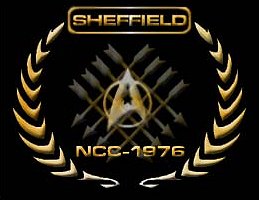
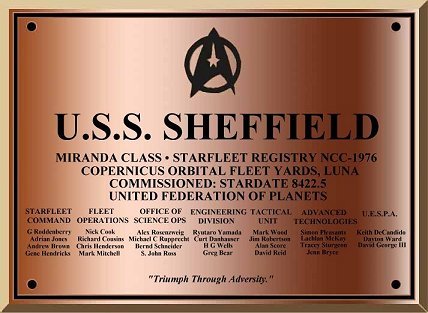 U.S.S. Sheffield is a twenty-five year old Federation starship. Sheffield is Miranda class light cruiser, a design that dates back to the 2260s. Sheffield continues a tradition that dates back to the light cruisers and frigates of the time of James T. Kirk. Smaller than Captain Demora Sulu's Enterprise-B, Sheffield is a Class 3 Light Cruiser with Class 1 defensive capabilities. She is 233 metres long and weighs over 655 000 tonnes. The normal crew compliment is 223 (23 officers and 200 enlisted) spread throughout her 11 decks. Sheffield has four shuttles and is the smallest Starfleet design with full exploration, scientific and diplomatic facilities; a truly flexible design. U.S.S. Sheffield currently has a compliment of 231 officers and crew (220 plus an additional 11 mission specialists for this current assignment).
U.S.S. Sheffield is a twenty-five year old Federation starship. Sheffield is Miranda class light cruiser, a design that dates back to the 2260s. Sheffield continues a tradition that dates back to the light cruisers and frigates of the time of James T. Kirk. Smaller than Captain Demora Sulu's Enterprise-B, Sheffield is a Class 3 Light Cruiser with Class 1 defensive capabilities. She is 233 metres long and weighs over 655 000 tonnes. The normal crew compliment is 223 (23 officers and 200 enlisted) spread throughout her 11 decks. Sheffield has four shuttles and is the smallest Starfleet design with full exploration, scientific and diplomatic facilities; a truly flexible design. U.S.S. Sheffield currently has a compliment of 231 officers and crew (220 plus an additional 11 mission specialists for this current assignment).
U.S.S. Sheffield was originally laid down on December 28th 2284. Her motto is 'Triumph through adversity'. The Sheffield was launched on November 17th 2285 and commissioned on stardate 8422.5 [2nd January 2286] from the Starfleet's Copernicus Luna Orbital Construction Yards. U.S.S. Sheffield was the twenty-second ship of Miranda class Flight 1c, which included NCC 1975 U.S.S. Ranger and NCC 1978 U.S.S. Coventry. The design of the Sheffield was the standard Miranda class configuration with torpedo-sensor roll-bar with outboard phaser cannons. This design has been little-changed since the original NX-1833, with the exception of the bridge module. During the height of the cold war between the Federation and the Klingons [and Romulans] the Sheffield patrolled the Neutral Zone borders, studying the outer colonies, their people, whilst scanning the subspace frequencies and observing fleet movements. Various sensor configurations, scientific equipment and intelligence-gathering technologies were tested during this time, including early Idionomothetic equipment.
The Miranda class design of Light Cruiser has various elements which aid in the usual workhorse mission she performs. The aft section of the Miranda is a combined area of main engineering, impulse and warp drives, photon torpedo system, pulse phaser cannon system and two large shuttle bays. Various configuration of shuttle fleets can be found in the various Miranda class starships. In the case of U.S.S. Sheffield, she has 1x executive shuttlecraft, 3x Galileo class multirole shuttles and 1x aeroshuttle. This starship is capable of independent operation for up to five years without refuelling. The average mission length is three for this class of starship. Every twenty years, the Sheffield is stripped bare and fully refit with the latest equipment. The last major refit took place in 2307, with a minor refit performed at Starbase 77 at the end of 2311, after the Tomed Incident. The modular design of Sheffield allows the systems to be easily replaced, repaired or upgraded with an emphasis on plug-in-and-play.
Author notes:
I always saw the Sheffield as an older starship with a past history. The Miranda class design always looked like a modular one that can swap outboard sensors and other equipment quickly and easily, like all Federation starships. The emphasis is on exploration and reseach, like most Starfleet starships. The name is for the city I grew up in and the three Royal Navy warships named in honour of my city.
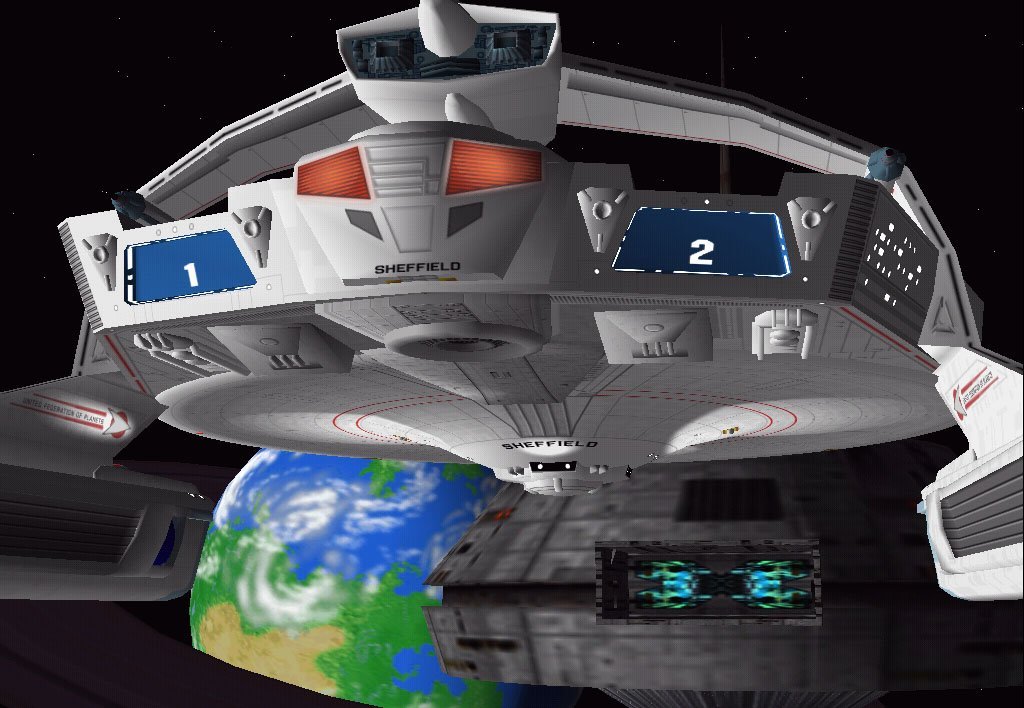 The main mission of U.S.S. Sheffield is exploration, diplomacy and research. Sheffield has Starbase-quality VIP quarters and conference facilities for conducting diplomatic functions up to and including first contact. The science facilities and laboratories on the Sheffield are up to Starbase quality and are cutting-edge. They are capable of performing dozens of individual studies or combining their facilities, personnel and equipment for larger projects. For the current mission, cultural and social scientific facilities on deck three are working on the races, worlds and colonies of the Klingon Empire and its neighbours. Physical science laboratories on deck seven assist in examining the physiological elements of the species as well as the climate and planetary science aspects. For those occasions where the use of force is unavoidable - and all other options have been exhausted - the Sheffield has an impressive array of defensive options, ranging from shields and deflector screens, up to phasers, twin pulse phaser cannons and 50 photon torpedoes.
The main mission of U.S.S. Sheffield is exploration, diplomacy and research. Sheffield has Starbase-quality VIP quarters and conference facilities for conducting diplomatic functions up to and including first contact. The science facilities and laboratories on the Sheffield are up to Starbase quality and are cutting-edge. They are capable of performing dozens of individual studies or combining their facilities, personnel and equipment for larger projects. For the current mission, cultural and social scientific facilities on deck three are working on the races, worlds and colonies of the Klingon Empire and its neighbours. Physical science laboratories on deck seven assist in examining the physiological elements of the species as well as the climate and planetary science aspects. For those occasions where the use of force is unavoidable - and all other options have been exhausted - the Sheffield has an impressive array of defensive options, ranging from shields and deflector screens, up to phasers, twin pulse phaser cannons and 50 photon torpedoes.
Author notes:
Star Trek occasionally reflects on the ongoing missions onboard like McGivers in "Space Seed", Data's experiments in "The Offspring", La Forge in "Interface" or Tom Paris building the Delta Flier in Voyager. Discovery lists they have 300 experiments going on; Sheffield is no different. As with Star Trek, Star Trek: Enterprise and Star Trek: Discovery, science and exploration is the driving force for the U.S.S. Sheffield.
The daily routine of the Sheffield includes a Captainís Table briefing in the briefing room on deck two. This is where the Commanding Officer is brought up to date by the heads of each division (Science, Engineering, Medical, Special Services, Security and Security Operations). This progress is measured against the short-term targets and the overall mission. The messages and action plans from this briefing are then fed down to each division in their own daily meetings. The science division heads are briefed in the deck two briefing room, the engineers have their own briefing room aft on deck four. Medical briefings are in their own medical block on deck seven, whilst Security do theirs in their own offices on deck seven. Security Operations are linked in with the flight teams aft on deck four for off-starship operations. Security Operations also work in the adjacent Operations Centre, liaising closely with sciences, medical and engineering to ensure the safety of away teams.
Author notes:
Verisimilatude is one of the driving factors for my portrayal of U.S.S. Sheffield and the Interim Years universe. How would starships like the Sheffield actually work? The answer is efficient leadership and communication. Each division focussed on their specialities, yet all working cohesively with each other to facilitate the Sheffield's overall mission. Royal Navy ships HMS Endurance and HMS Protector are a good role model for this.
The late 2280s was a period of intense political tensions between the Klingon Empire and the Federation. Sheffield's first mission was to examine the Klingon disposition along the Neutral Zone border. Amongst the first Idionomothetic subjects were Chancellor Gorkon, General Chang, Kor, Kang, Koloth and one or two studies of Brigadier Kerla. This first mission covered the Whaleprobe Crisis and the Nimbus III hostage situation. This mission also covered the change in leadership to Gorkon and the increasingly beligerent nature of the Klingons towards the Federation.
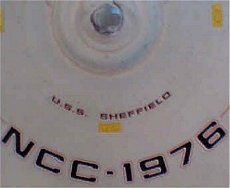 The second mission from 2291 covered the events up to, during and the aftermath of the Praxis explosion. Just how close the Sheffield was to the explosion still remains classified. What is known is that as soon as the mission allowed, U.S.S. Sheffield put into Starbase 20 "Key Stone" for structural repairs. U.S.S. Sheffield was of primary importance for an assessment of the Klingon Empire following the explosion of Praxis and the assassination of Chancellor Gorkon. The Idionomothetics department came into its own, assessing the political situation and aiding predictions into the future situations on Qo'noS. The Sheffield's mission concluded in 2295 where the starship underwent a refit programme for her next mission from 2296 - 2298.
The second mission from 2291 covered the events up to, during and the aftermath of the Praxis explosion. Just how close the Sheffield was to the explosion still remains classified. What is known is that as soon as the mission allowed, U.S.S. Sheffield put into Starbase 20 "Key Stone" for structural repairs. U.S.S. Sheffield was of primary importance for an assessment of the Klingon Empire following the explosion of Praxis and the assassination of Chancellor Gorkon. The Idionomothetics department came into its own, assessing the political situation and aiding predictions into the future situations on Qo'noS. The Sheffield's mission concluded in 2295 where the starship underwent a refit programme for her next mission from 2296 - 2298.
This mission focussed on the Klingon/Romulan Border War and the continuing turmoil in the Klingon High Council. It was during this mission that the extent of the damage inflicted on the Klingon Empire, both from the explosion of Praxis and the Romulans, could be ascertained. Together with data from the Victory and Montrose aid missions to Qo'noS, the data from U.S.S. Sheffield showed that the Klingon Empire had been critically weakened, with many shipyards destroyed or unable to operate from either lack of resources or lack of energy. This news focussed the efforts of the fledgling Idionomothetics team to work in concert with the U.S.S. Montrose to compile data on Chancellor Azetbur and the High Council with regards to their stability of position, given the extent of the crisis.
The mission 2299 - 2305, with the emphasis again on the Klingon Empire and the effects post-Praxis. U.S.S. Sheffield is said to be the starship that first learned of the fall of the Ch'ramak system at the hands of the Klingon fleet, passing this information up to the Commodores and Admirals further up the chain of command. The exact position of the Sheffield when she picked up this information is still classified, although there are suspicions that the U.S.S. Sheffield used her 'stealth' abilities to be actually present in the system when it fell.
2306 - 2311 the Sheffield was under the command of Captain Okigbo, with Lieutenant Commander Nathaniel Hawkins as his Executive Officer. The Sheffield was assigned to explore sector 16334 during the rising tensions with the Romulans. Hawkins was onboard to use the state-of-the-art idionomothetics equipment, whereas Okigbo was one of the finest diplomats on the Starfleet. Tensions eventually escalated to the point where war seemed inevitable, but the Tomed Incident saw the Romulans finally withdraw behind the Neutral Zone. The Sheffield went to Starbase 20 "Key Stone" for a thorough refit and Nathaniel Hawkins became her caretaker C.O. as this was performed.
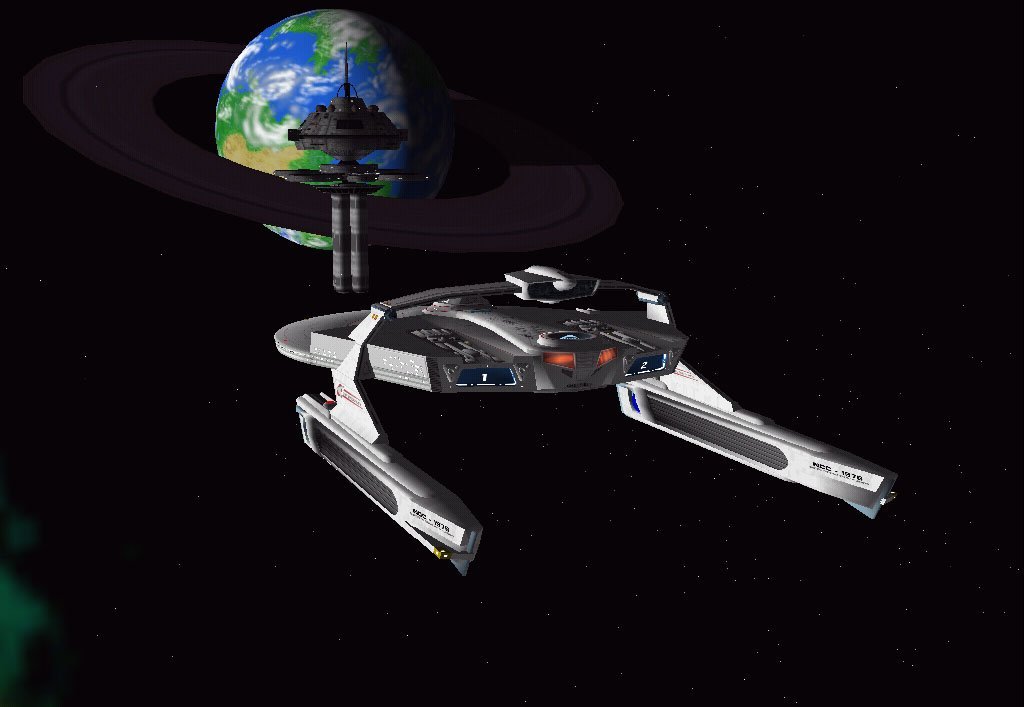 2309 - 2311 crew:
2309 - 2311 crew:
Commanding Officer - Captain Raekwon Okigbo
Executive Officer - Commander Nathaniel Hawkins
Operation Officer - Lieutenant Commander
Mission Operation Officer - Lieutenant
Chief Medical Officer - Doctor
Chief Engineering Officer - Lieutenant Commander Sean O'Reilly
Chief Science Officer - Lieutenant Commander
Communications Officer - Lieutenant (junior grade) Kara Fox
Helmsman - Lieutenant (junior grade) Chikran
Navigator - Ensign Aarama (Deltan male)
Chief Special Services Officer -
Chief Security Officer (Andorian male)
Chief Security Operations Officer (Michael Chiklis)
As of 2312, Sheffield is currently under the command of Captain Nathaniel Hawkins and has 231 crew assigned.
Commanding Officer - Captain Nathaniel Hawkins
Executive Officer - Commander Ilani (Deltan female)
Operation Officer - Lieutenant Commander S'sana (Orion/Romulan female)
Mission Operation Officer - Lieutenant Commander T'daen (Vulcan female)
Chief Medical Officer - Doctor Jobin A'ochak (Grazerite male)
Chief Engineering Officer - Lieutenant Commander Hars Lodra (Bolian)
Chief Science Officer - Lieutenant Commander Judith Peers
Communications Officer - Lieutenant (junior grade)
Tissiah Sh'chyllar (cyber-enhanced Andorian Shen female)
Helmsman - Lieutenant (junior grade) Temir Bihrehn (unjoined Trill male)
Navigator - Ensign Gashlar Grul (Tellarite male)
Chief Special Services Officer - Lieutenant Commander Jirras (Orion)
Chief Security Officer - Lieutenant Oggta (Saurian male)
Chief Security Operations Officer - Lieutenant Arin Zh'Thera (Andorian Zhen female)
Social Sciences Officer Lieutenant Vheriel (Aenar female)
Crew species make-up:
The Bridge crew species composition reflects the diversity aboard the Sheffield, which is typical amongst Starfleet starships. This reflects the make-up of both Starfleet and the United Federation of Planets; a rich and diverse culture to grow up in and explore together. U.S.S. Sheffield has 220 regular crew plus 11 mission specialists aboard. This is not the 'Homo sapiens-only club that Chancellor Azetbur spoke so distastefully of. The species composition of the crew is as follows:
Humans - 29 (5 of which are from Earth, the rest from colonies).
Vulcans - 26
Tellarites - 28
Andorians - 28
Rigelians - 21
Deltans - 11
Betazoids - 8
Caitians - 9
Aenar - 1
Orions - 14
Axanari - 11
Trill - 11
Saurians - 12
Bolians - 7
Tiburonian - 2
Aamazzarites - 1 (TMP)
Megaran - 1
Benzite - 3
Aamazaran - 1
Zaranite - 2 (Fluorine-breathers)
Venturi - 1
Barzan - 1
Arcturan Clone - 2
Monchezkin - 1 (JJ Trek)
The Mission: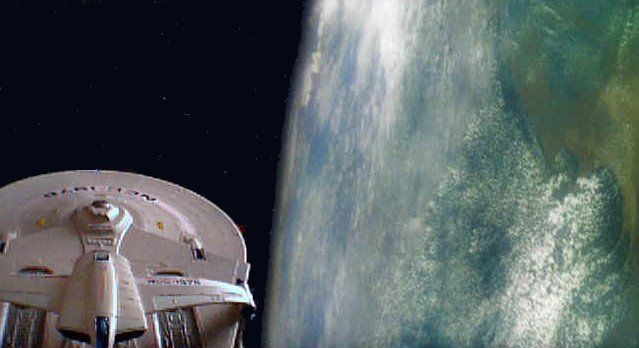
Starfleet has decided that, in the light of the Romulan withdrawal following the Tomed Incident and the Klingons settling in with their new Chancellor, Kaarg, this is an ideal opportunity to re-evaluate the status quo in the Beta Quadrant. Information is a vital asset to the Federation is conflict-prevention. Ever since the 2290's, the Beta Quadrant has become, if anything, even more unstable with rebel Klingon factions and unrest in the Romulan Empire. Sheffield's mission is to see what the political, strategic and tactical situation is across the border from the Federation, and to feed that information back securely to Starfleet Intelligence and Starfleet Tactical. With the current Ch'ramak terrorism situation sharp in everybody's mind, gathering accurate data on the Federation frontier region in the Beta Quadrant has never been more important.
U.S.S. Sheffield Technical details [by Michael C. Rupprecht, Alex Rosenzweig and Memory Alpha]:
U.S.S. Sheffield is a Class 3 Light Cruiser with Class 1 defensive capabilities.
Length: 233 metres
Beam: 142 metres
Height: 58 metres
Crew: 231 [35 officers, 196 enlisted]
Cruising Warp 7 [OCU]
Max Warp 11 [OCU]
Maximum Speed: Warp 9.2 for 12 hours (new scale)
Armament: 6 dual type-7 phaser banks; 2 pulse phaser cannons; 4 photon torpedo launchers
Defences: Deflector shields
U.S.S. Sheffield has 11 Decks:
Primary Hull:
01 COMMAND DECK Main Bridge, Ready Room
02 EXECUTIVE DECK - First and Second Officers offices and Briefing room.
03 Senior Crew Quarters, Junior Crew Quarters, Crew Quarters, CULTURAL & SOCIAL SCIENCES: Social Sciences Department, Arts Centre, Anthropology, Archeology, Ergonomics, Navigational Sciences, Metallurgy, Linguistics, Political Sciences, History, Electronics, Chapel & Economics.
04 VIP lounge, Officers Quarters, Arboretum, Quartermasters office, Mathematics and statistics laboratories, aeronautics and aquanautics labs, Main Deflector, Main Impulse Drive, Deuterium Tanks, Main Engineering, Ops Centre and Briefing room with 2 offices.
05 Officers mess, Gym, Recreation Deck, Jacuzzi, Swimming pool, Crew Quarters, Aquarium.
06 Crewman and NCO quarters, Food synthesis equipment, Primary navigational deflector, Shuttlebays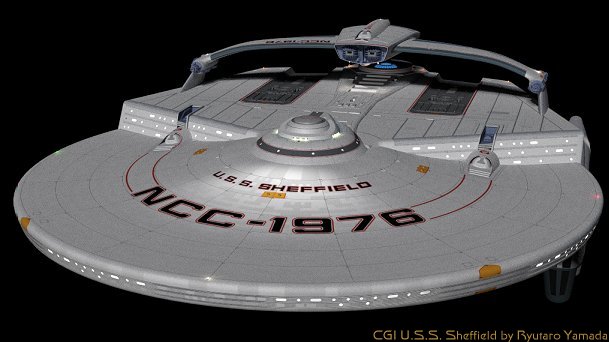 07 Main deck - Sickbay, Transporter Room PHYSICAL SCIENCES: Physics, High-Energy, Quantum, Chaos and Particle physics labs. Chemistry, Biochemistry, Biophysics, Paleontology, Planetary Sciences, Genetics, Oceanography & Ecology.
08 DOCKING LEVEL - Docking ports, Aux fire control, Fabrication facility, Laundry, Reclamation, Anti-matter Storage, Cargo
09 INTELLIGENCE DECK - Computer laboratory, Intelligence department, Temperature regulation
Cargo
10 Circuit breaker deck Cargo
11 Main Sensor Array, Navigation dome
07 Main deck - Sickbay, Transporter Room PHYSICAL SCIENCES: Physics, High-Energy, Quantum, Chaos and Particle physics labs. Chemistry, Biochemistry, Biophysics, Paleontology, Planetary Sciences, Genetics, Oceanography & Ecology.
08 DOCKING LEVEL - Docking ports, Aux fire control, Fabrication facility, Laundry, Reclamation, Anti-matter Storage, Cargo
09 INTELLIGENCE DECK - Computer laboratory, Intelligence department, Temperature regulation
Cargo
10 Circuit breaker deck Cargo
11 Main Sensor Array, Navigation dome
Author's Notes:
The U.S.S. Sheffield is a light cruiser, very much in the vein of the first HMS Sheffield C24, which was Town-class Large Light Cruiser. The ST: TNG Technical Manual [page 179] talks of Starfleet having lots of smaller, mission-specific starships. Sheffield is not one of those, but s actually the smallest design of ship equally able to perform diplomatic missions, cultural surveys and following up the work of the larger Cruisers and Explorers, like the Enterprise, that do the First Contact and studies over two weeks before moving on. Personally I believe it is far more interesting to write about an average standard ship than the flagship of the fleet, you've less torpedoes and more need to be diplomatic, think and talk it out.
September 28th 2002 will be remembered by me not only as the day I watched the Chinese State Circus, but also the day U.S.S. Sheffield finally really came to life. My friend Nick Cook and the others of the U.S.S. Intrepid Star Trek group in Dundee bought me a going away present which was delivered on this day: Plans for U.S.S. Sheffield, NCC 1976, by Michael C. Rupprecht and Alex Rosenzweig. These plans, published by Federation Frontiers, are the closest thing to official plans of the Miranda class to date. My friend Nick had fooled me into believing questions about this ship were purely for this website, when in reality he contacted the above designers to print off the plans as U.S.S. Sheffield, complete with new logo and motto that I had come up with myself. I guess this was my thirty-and-three-quarters birthday present...
July 25th 2005 is another day I will always treasure as I received an e-mail from Ryutaro Yamada, AKA Fesarius, which contained a CGI image of U.S.S. Sheffield - shown on the index page of this website and on this page as well. This really brought the U.S.S. Sheffield alive for me. We had a model, the deck plans and a feel for what she was like, now we have an image of her with all the lights on. Beautiful. Thank you, Fesarius.
HMS Sheffield: namesake of NCC 1976:
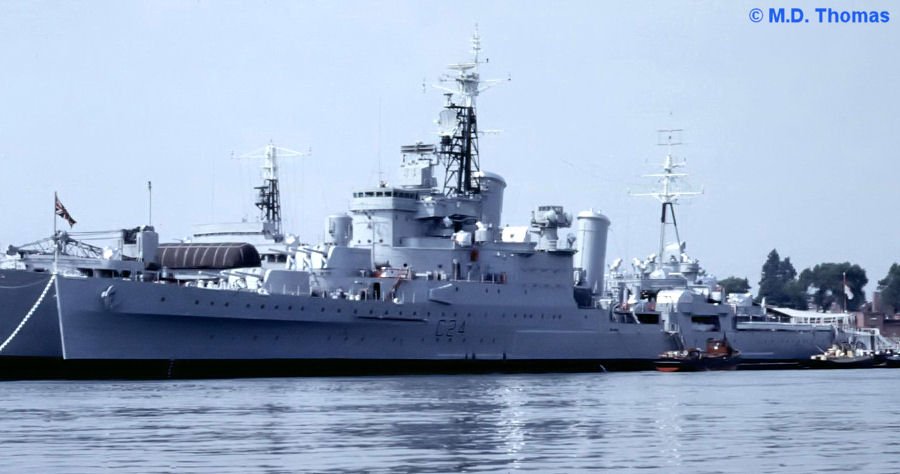
The above image is copyright M. D. Thomas. Click on this image for a link to the Haze Grey website.
This is 'Old Shiny, the Southampton class HMS Sheffield [1] from 1937 -1967. Her battle honours: Norway 1940, Spartivento 1940, Atlantic 1941-43, 'Bismarck' 1941,
Mediterranean 1941, Malta Convoys 1941, Arctic 1941-43, North Africa 1942, Barents Sea 1942, Biscay 1943, Salerno 1943 and North Cape 1943.
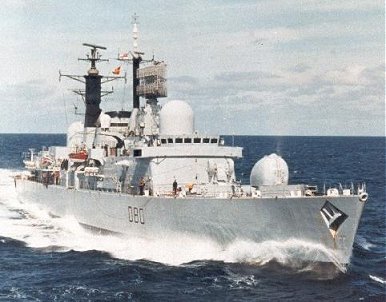
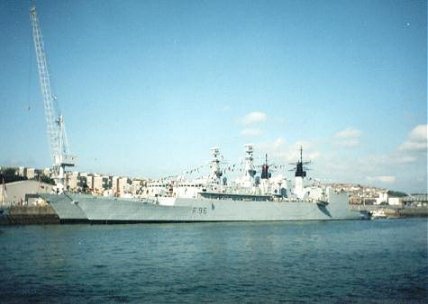
Here are 'Shiny Sheff' from the Falklands War. Her life was a short 1971 - 1982. She was the class ship of the Sheffield class Type 42 destroyers. Her battle honour was the Falklands War 1982. 'New shiny' was a Type 22 batch 2 Broadsword class frigate. She lasted from 1988 - 2002.
The latest Shiny Sheff is the Type 26 frigate or Global Combat Ship (F264). Due for launch in the late 2020s.
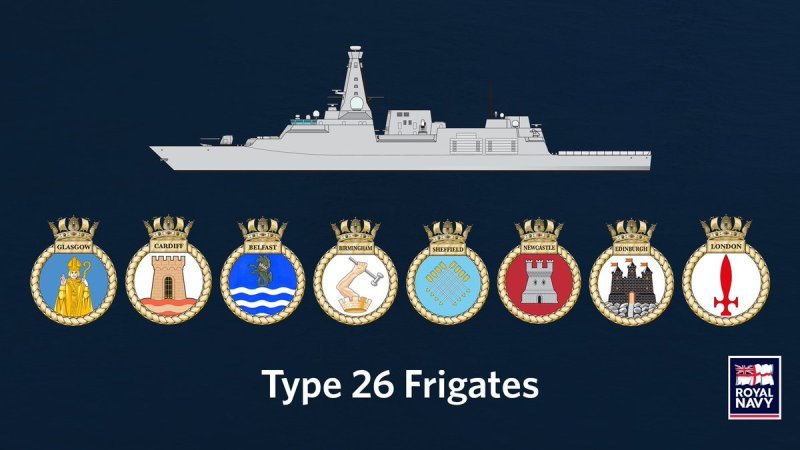













 U.S.S. Sheffield is a twenty-five year old Federation starship. Sheffield is Miranda class light cruiser, a design that dates back to the 2260s. Sheffield continues a tradition that dates back to the light cruisers and frigates of the time of James T. Kirk. Smaller than Captain Demora Sulu's Enterprise-B, Sheffield is a Class 3 Light Cruiser with Class 1 defensive capabilities. She is 233 metres long and weighs over 655 000 tonnes. The normal crew compliment is 223 (23 officers and 200 enlisted) spread throughout her 11 decks. Sheffield has four shuttles and is the smallest Starfleet design with full exploration, scientific and diplomatic facilities; a truly flexible design. U.S.S. Sheffield currently has a compliment of 231 officers and crew (220 plus an additional 11 mission specialists for this current assignment).
U.S.S. Sheffield is a twenty-five year old Federation starship. Sheffield is Miranda class light cruiser, a design that dates back to the 2260s. Sheffield continues a tradition that dates back to the light cruisers and frigates of the time of James T. Kirk. Smaller than Captain Demora Sulu's Enterprise-B, Sheffield is a Class 3 Light Cruiser with Class 1 defensive capabilities. She is 233 metres long and weighs over 655 000 tonnes. The normal crew compliment is 223 (23 officers and 200 enlisted) spread throughout her 11 decks. Sheffield has four shuttles and is the smallest Starfleet design with full exploration, scientific and diplomatic facilities; a truly flexible design. U.S.S. Sheffield currently has a compliment of 231 officers and crew (220 plus an additional 11 mission specialists for this current assignment). The main mission of U.S.S. Sheffield is exploration, diplomacy and research. Sheffield has Starbase-quality VIP quarters and conference facilities for conducting diplomatic functions up to and including first contact. The science facilities and laboratories on the Sheffield are up to Starbase quality and are cutting-edge. They are capable of performing dozens of individual studies or combining their facilities, personnel and equipment for larger projects. For the current mission, cultural and social scientific facilities on deck three are working on the races, worlds and colonies of the Klingon Empire and its neighbours. Physical science laboratories on deck seven assist in examining the physiological elements of the species as well as the climate and planetary science aspects. For those occasions where the use of force is unavoidable - and all other options have been exhausted - the Sheffield has an impressive array of defensive options, ranging from shields and deflector screens, up to phasers, twin pulse phaser cannons and 50 photon torpedoes.
The main mission of U.S.S. Sheffield is exploration, diplomacy and research. Sheffield has Starbase-quality VIP quarters and conference facilities for conducting diplomatic functions up to and including first contact. The science facilities and laboratories on the Sheffield are up to Starbase quality and are cutting-edge. They are capable of performing dozens of individual studies or combining their facilities, personnel and equipment for larger projects. For the current mission, cultural and social scientific facilities on deck three are working on the races, worlds and colonies of the Klingon Empire and its neighbours. Physical science laboratories on deck seven assist in examining the physiological elements of the species as well as the climate and planetary science aspects. For those occasions where the use of force is unavoidable - and all other options have been exhausted - the Sheffield has an impressive array of defensive options, ranging from shields and deflector screens, up to phasers, twin pulse phaser cannons and 50 photon torpedoes. The second mission from 2291 covered the events up to, during and the aftermath of the Praxis explosion. Just how close the Sheffield was to the explosion still remains classified. What is known is that as soon as the mission allowed, U.S.S. Sheffield put into Starbase 20 "Key Stone" for structural repairs. U.S.S. Sheffield was of primary importance for an assessment of the Klingon Empire following the explosion of Praxis and the assassination of Chancellor Gorkon. The Idionomothetics department came into its own, assessing the political situation and aiding predictions into the future situations on Qo'noS. The Sheffield's mission concluded in 2295 where the starship underwent a refit programme for her next mission from 2296 - 2298.
The second mission from 2291 covered the events up to, during and the aftermath of the Praxis explosion. Just how close the Sheffield was to the explosion still remains classified. What is known is that as soon as the mission allowed, U.S.S. Sheffield put into Starbase 20 "Key Stone" for structural repairs. U.S.S. Sheffield was of primary importance for an assessment of the Klingon Empire following the explosion of Praxis and the assassination of Chancellor Gorkon. The Idionomothetics department came into its own, assessing the political situation and aiding predictions into the future situations on Qo'noS. The Sheffield's mission concluded in 2295 where the starship underwent a refit programme for her next mission from 2296 - 2298. 2309 - 2311 crew:
2309 - 2311 crew:













